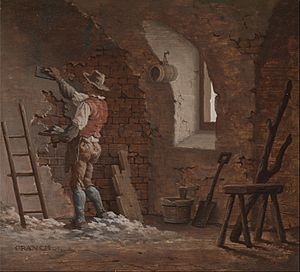John Cranch (English painter) facts for kids

John Cranch (1751–1821) was an English painter. He was born in Kingsbridge, Devon, on October 12, 1751. From a young age, John taught himself how to draw, write, and play music. While working as a clerk in Axminster, he also received some art lessons from a priest. Later, he inherited some money, which allowed him to move to London. There, he began painting portraits and historical scenes.
Contents
Becoming an Artist
John Cranch worked hard to become a recognized artist. He tried to show his paintings at the famous Royal Academy but was not successful there. However, he had more luck with other art groups.
Showing His Work
Cranch showed his art at the Society of Artists. One of his notable paintings there was Burning of the Albion Mills. He also displayed eight pictures at the British Institution in 1808.
Famous Paintings
One of John Cranch's most well-known paintings was The Death of Chatterton. This painting showed a dramatic historical event. Another of his works, Playing with Baby, can be seen today at the Victoria and Albert Museum.
Unique Art Style
John Cranch was also known for a special type of art called "poker-pictures." This is a technique where designs are burned onto wood or other materials using a hot poker. It's like drawing with heat!
Connections and Recognition
Cranch was friends with Sir Joshua Reynolds, a very famous painter of that time. Reynolds had received help from a Mr. and Mrs. Cranch when he was younger, who were likely John's relatives.
International Honors
John Cranch received recognition from across the ocean. In 1797, he was made an honorary member of the American Academy of Arts and Sciences. Later, in 1818, he became a member of the American Antiquarian Society. These honors showed that his artistic talent was appreciated far and wide.
Later Life and Writings
After living for many years in Bath, John Cranch passed away there in February 1821, when he was 69 years old. Besides painting, he also wrote two books. One was called On the Economy of Testaments (published in 1794). The other, published in 1811, was titled Inducements to promote the Fine Arts of Great Britain by exciting Native Genius to independent Effort and original Design. In this book, he encouraged British artists to be creative and original.

